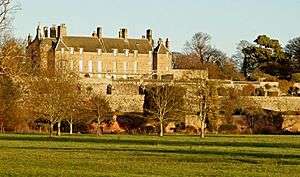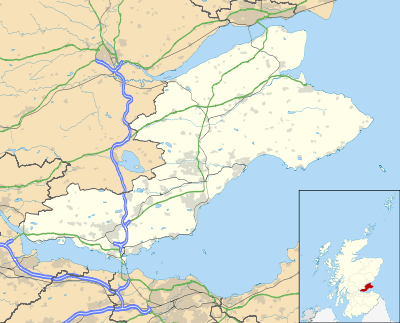Balcaskie
Balcaskie is a 17th-century country house in Fife, Scotland. It lies around 2 km north of St Monans, and is notable chiefly as the home and early work of architect Sir William Bruce.
| Balcaskie | |
|---|---|
 Balcaskie from the south | |
 Location within Fife | |
| General information | |
| Coordinates | 56°13′19″N 2°45′59″W |
| Design and construction | |
| Architect | William Bruce |
Listed Building – Category A | |
| Official name | Balcaskie House |
| Designated | 1 March 1984 |
| Reference no. | LB2503 |
| Official name | Balcaskie |
| Designated | 1 July 1987 |
| Reference no. | GDL00037 |
Robert Lorimer, an admirer of Bruce, called the house "the ideal of what a Scottish gentleman's home ought to be".[1] Balcaskie remains the seat of the Chief of the Name and Arms of Anstruther,[2] Tobias Alexander Anstruther of that Ilk.[3]
History
The original Balcaskie House (Castle) was built some time before 1629, as the home of the Moncrieffs of that Ilk, and was a traditional L-plan fortified house of four storeys.
In 1665 the estate was bought by Sir William Bruce, who set about enlarging the house for his own use, between 1668 and 1674. Bruce planned the new house himself and employed John Hamilton as mason, and Andrew Waddell as wright (carpenter). The house was expanded from the L-plan to an almost symmetrical U-plan, with the original building at the west end. The north front was given matching crow-step gables, with a balustraded two-storey central section. In addition, Bruce added tall corner towers to each angle. These had French-inspired details such as rusticated quoins. Bruce may have built the curving wing-walls and pavilions to the north front, however, these have also been attributed to a later building phase.
The estate was sold in 1684 to Sir Thomas Steuart, when Bruce moved to his new home at Kinross House. In 1698 it changed hands again, becoming the property of Sir Robert Anstruther, whose son Philip undertook works in the mid-18th century, including heightening the central block. It was now that the wing walls and pavilions were added, according to John Gifford. Further alterations were made by William Burn in 1830-32, including a porch and new windows, and a stable block. In 1856-58 David Bryce, a Scottish architect, worked at Balcaskie, adding several baronial features.
Gardens
The gardens, to the south of the house, were laid out by William Bruce and are aligned on the Bass Rock. The terraces and vista are inspired by French Baroque gardens, such as Vaux-le-Vicomte. The gardens were altered in the 18th century, and restored in 1826-7 by William Burn and William Sawrey Gilpin. Sir Walter Scott visited the gardens in 1827 and described the house as "much dilapidated" but praised the restoration of the gardens.[4]
Parterres were laid out in the 1840s by W. A. Nesfield.
References
- Lorimer, Robert Architectural Review, November 1899, cited in Glendinning et al., p.340
- "MyClan.com : Clan Anstruther : Clan History". 12 March 2007. Archived from the original on 12 March 2007. Retrieved 20 December 2016.
- "Archived copy". Archived from the original on 26 July 2011. Retrieved 26 May 2009.CS1 maint: archived copy as title (link)
- Scotland's Lost Gardens, Marilyn Brown
Bibliography
- Gifford, John (1988) The Buildings of Scotland : Fife, Penguin, ISBN 978-0140710779
- Glendinning, Miles, MacInnes, Ranald, & MacKechnie, Aonghus (1996) A History of Scottish Architecture, Edinburgh University Press, ISBN 978-0748608492